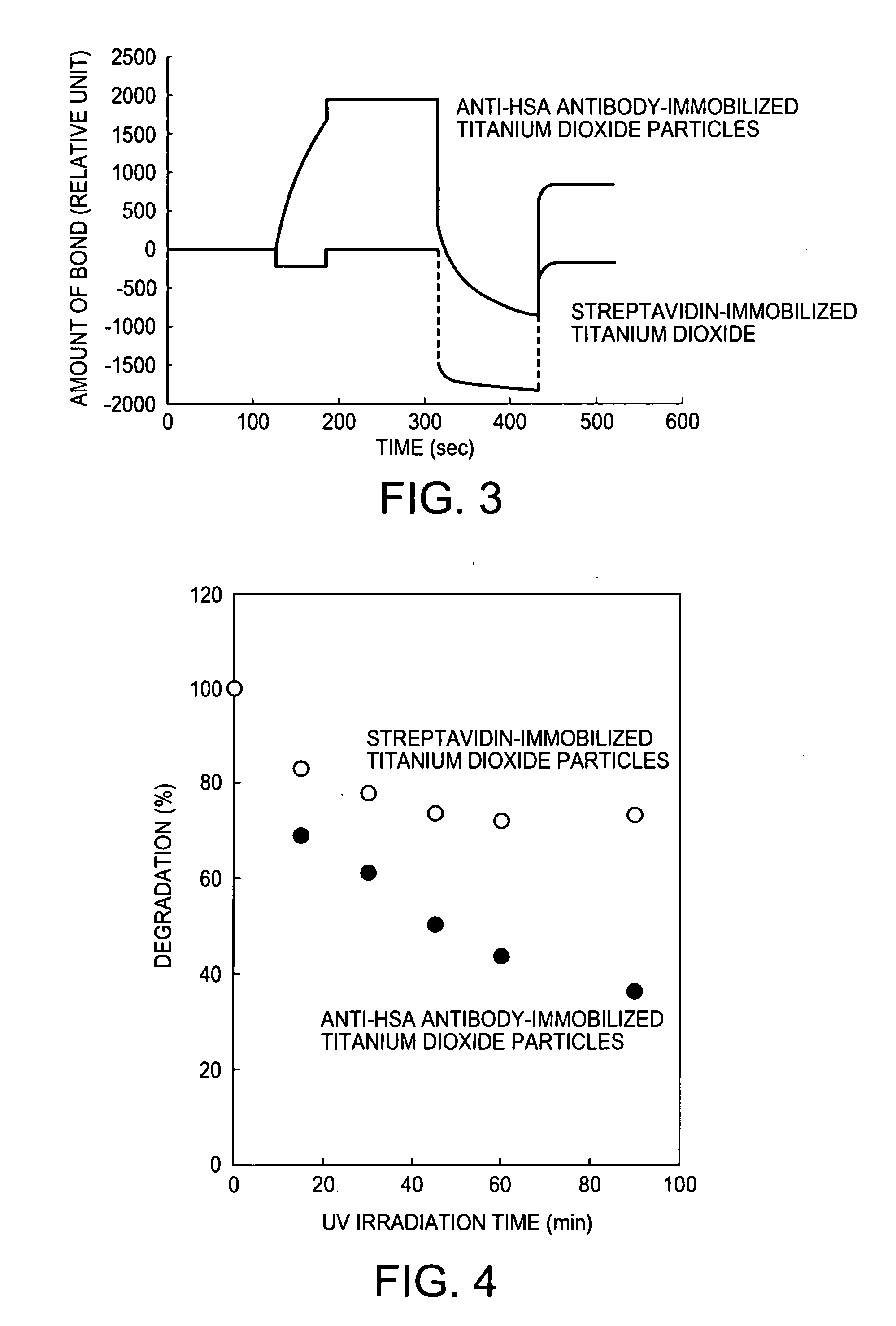Titanium dioxide complex having molecule distinguishability
a technology of titanium dioxide and complexes, which is applied in the field of titanium dioxide composites having molecular recognition capacity, can solve the problems of inability to selectively remove or degrade bound endocrine disrupting chemicals, limited cleaning capacity, and inability to achieve selective binding and degradation of only endocrine disrupting chemicals, so as to achieve accurate recognition and capture a target molecule, high degradation activity, and high photocatalytic activity
- Summary
- Abstract
- Description
- Claims
- Application Information
AI Technical Summary
Benefits of technology
Problems solved by technology
Method used
Image
Examples
example 1
[0028] Introduction of Polyacrylic Acid into Titanium Dioxide Particles
[0029] Titanium tetraisopropoxide (3.6 g) and 3.6 g of isopropanol were mixed together, and the mixture was added dropwise to 60 ml of ultrapure water under ice cooling for hydrolysis. After the completion of the dropwise addition, the reaction solution was stirred at room temperature for 30 min. After the stirring, 1 ml of 12 N nitric acid was added dropwise thereto, and the mixture was stirred at 80° C. for 8 hr for peptization. After the completion of the peptization, the reaction solution was filtered through a 0.45-μm filter, followed by solution exchange through a desalination column (PD10; Amersham Biosciences K.K.) to prepare an anatase-form titanium dioxide sol having a solid content of 1%. This dispersion liquid was placed in a 100 ml-volume vial bottle and was ultrasonicated at 200 Hz for 30 min. The average diameter of the dispersed particles before the ultrasonication and the average diameter of the...
example 2
[0031] Immobilization of Anti-AFP Antibody Molecule on Polyacrylic Acid-Modified Titanium Dioxide Fine Particles
[0032] The polyacrylic acid-modified titanium dioxide sol (anatase form) (1 ml) prepared in Example 1 was subjected to solution exchange through a desalination column PD10 to prepare 3 ml of a polyacrylic acid-modified titanium dioxide sol dispersed in water. A mixed liquid (O.1 ml) composed of 200 mM 1-ethyl-3-(3-dimethylaminopropyl)carbodiimide and 50 mM N-hydroxysuccinimide (NHS) was added to 1.5 ml of this solution. The mixture was stirred for 10 min to activate the carboxyl groups. After the stirring, the reaction solution was subjected to solution exchange through PD10 equilibrated with a 10 mM acetate buffer solution (pH 5.0) to give 3 ml of a carboxyl-activated polyacrylic acid-modified titanium dioxide sol dispersed in a 10 mM acetate buffer solution (pH 5.0). An anti-α-fetoprotein (anti-AFP) polyclonal antibody (goat IgG, SC-8108; Cosmo-Bio Co., Ltd.) prepared u...
example 3
[0033] Immobilization of Anti-HSA Antibody Molecule on Polyacrylic Acid-Modified Titanium Dioxide Fine Particles
[0034] The polyacrylic acid-modified titanium dioxide sol (anatase form) (1 ml) prepared in Example 1 was subjected to solution exchange through a desalination column PD10 to prepare 3 ml of a polyacrylic acid-modified titanium dioxide sol dispersed in water. A mixed liquid (0.1 ml) composed of 200 mM 1-ethyl-3-(3-dimethylaminopropyl)carbodiimide and 50 mM N-hydroxysuccinimide (NHS) was added to 1.5 ml of this solution. The mixture was stirred for 10 min to activate the carboxyl groups. After the stirring, the reaction solution was subjected to solution exchange through PD10 equilibrated with a 10 mM acetate buffer solution (pH 5.0) to give 3 ml of a carboxyl-activated polyacrylic acid-modified titanium dioxide sol dispersed in a 10 mM acetate buffer solution (pH 5.0). An anti-human serum albumin (anti-HSA) monoclonal antibody (mouse IgG, MSU-304; Cosmo-Bio Co., Ltd.) pre...
PUM
| Property | Measurement | Unit |
|---|---|---|
| Particle diameter | aaaaa | aaaaa |
| Hydrophilicity | aaaaa | aaaaa |
Abstract
Description
Claims
Application Information
 Login to View More
Login to View More - R&D
- Intellectual Property
- Life Sciences
- Materials
- Tech Scout
- Unparalleled Data Quality
- Higher Quality Content
- 60% Fewer Hallucinations
Browse by: Latest US Patents, China's latest patents, Technical Efficacy Thesaurus, Application Domain, Technology Topic, Popular Technical Reports.
© 2025 PatSnap. All rights reserved.Legal|Privacy policy|Modern Slavery Act Transparency Statement|Sitemap|About US| Contact US: help@patsnap.com


